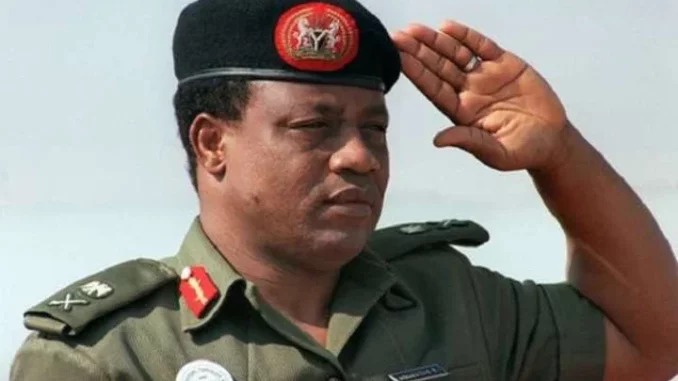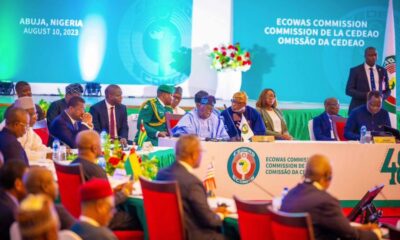According To Oldnaija, Here we go behind the historic June 12, 1993 presidential election in Nigeria. This election is considered the freest and fairest election in the annals of Nigeria’s history. Then why was it annulled? Background On the 31st of December, 1983, the military aborted the second attempt of Alhaji Sheu Shagari to run a democratic government due to gross electoral misconducts that happened during the…Click Here To Continue Reading>> …Click Here To Continue Reading>>
Background
On the 31st of December, 1983, the military aborted the second attempt of Alhaji Sheu Shagari to run a democratic government due to gross electoral misconducts that happened during the election. The military seized power in a bloodless coup and installed Major-General Mohammadu Buhari as the Head of State and the Commander-In-Chief of the armed forces.
Realizing Buhari’s administration had no intention of returning power to the democratic government, Gen. Ibrahim Babangida, the Chief of Army Staff to Maj.-Gen. Buhari seized the power in a bloodless coup on the 27th of August, 1985 and instantly began to plan the transition to a civil rule programme.
After several false declarations that the transition programme had commenced, President Babangida’s military administration found itself under much pressure within and outside the country to return power to the democratic government. Unable to bear the pressure, President Babangida’s administration set up an electoral commission (National Electoral Commission) under the chairmanship of Prof. Humphrey Nwosu to conduct an election that will usher in the much desired democratic government.
June 12 1993 Presidential Election
The National Electoral Commission (NEC) registered two political parties for the election. The two parties were: Social Democratic Party (SDP) with M.K.O. Abiola as the party’s flag bearer; and National Republican Convention (NRC) which had a Kano businessman, Bashiru Tofa, as its flag bearer. The political parties, both SDP and NRC, lavished a huge sum of money on their political campaigns. In fact, the campaigns were considered the “most robust” political campaigns in Nigeria.
However, the chairman of NEC, Prof. Humphrey Nwosu and other officials of the electoral commission set June 12, 1993 as the date for the presidential election which was to bring an end to the military regime of President Babangida
For the first time in the history of Nigeria, almost all eligible Nigerians trooped out to cast their votes. More than half of the votes went to M.K.O. Abiola which thus gave him a clean victory over his opponent, Bashiru Tofa. In fact, Bashiru Tofa lost in his ward which showed how acceptable M.K.O. Abiola was throughout the Country.
Result of the June 12, 1993 presidential election:.
Social Democratic Party (SDP) – 8,341,309 = 58.36%
National Republican Convention (NRC) – 5,952,087 = 41.64%
TOTAL- 14,293,396- 100%
The Annulment READ FULL STORY HERE>>>CLICK HERE TO CONTINUE READING>>>
No sooner had NEC began to announce the result of the election than President Ibrahim Babangida declared it annulled. In the annulment speech delivered by Babangida, he said
The whole world was stunned and enraged, particularly Nigerians. This was followed by riots, street protests and planned civil disobedience. The country was thrown into sudden chaos. Consequently, President Babangida stepped aside on the 26th of August 1993 and set up the Chief Earnest Shonekan led Interim National Government which Gen. Sanni Abacha later sacked on November 17, 1993, and took over the government. This again caused fresh riots and protests in the country which left many people locked behind bars and some, dead.
Abiola Versus Abacha
For some reasons, M.K.O. Abiola believed that Gen. Sanni Abacha, the new Head of State, will hand over power back to him and therefore persuaded many of his followers to support his administration. But the reverse was the case! Abacha didn’t do what M.K.O. Abiola had expected him to do.
This enraged Abiola and forced him to declare a Government of National Unity at Epetedo in Lagos, on the 11th of June, 1994. In a speech titled ‘Enough is Enough’, Abiola said,
Abiola’s action led to his arrest and imprisonment. Two years later, while struggling to restore her husband’s mandate, Abiola’s wife, Alhaja Kudirat Abiola, was assassinated on the 4th of June, 1996. Abacha’s government was accused of the assassination.
Gen. Sani Abacha’s iron-handed regime came to an end on the 8th of June, 1998 due to his sudden death which cause, till today, remains controversial.
M.K.O Abiola’s Controversial Death
Thirty days later, 7th of July, 1998, Abiola died in the presidential clinic after a meeting with some American delegates at the Akinola Aguda House in the presidential villa. The American delegates were Thomas Pickering, US under-secretary for political affairs, Susan Rice, assistant secretary of state for Africa and William Twaddell who was the US ambassador to Nigeria.
Gen. Abdulsalam Abubakar had taken over the government on the 9th of June, 1998, immediately after Abacha’s death. He eventually handed power over to the democratic government of Chief Olusegun Obasanjo on the 29th of May, 1999. Now Discover More History News And Others
See How Aguiyi-ironsi Was Marched Into The Bush, And Shot During July 1966 Coup – Ex-ADC


 SPORTS10 months ago
SPORTS10 months ago
 SPORTS10 months ago
SPORTS10 months ago
 SPORTS11 months ago
SPORTS11 months ago
 IN-THE-NEWS6 months ago
IN-THE-NEWS6 months ago
 METRO10 months ago
METRO10 months ago
 IN-THE-NEWS10 months ago
IN-THE-NEWS10 months ago
 SPORTS11 months ago
SPORTS11 months ago
 IN-THE-NEWS6 months ago
IN-THE-NEWS6 months ago


